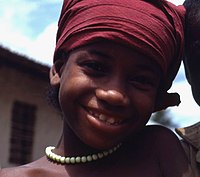Toma people
 |
|
| Total population | |
|---|---|
| 309,000 | |
| Regions with significant populations | |
|
|
144,000 |
|
|
165,000 |
| Languages | |
| Loma | |
| Religion | |
| Loma religion, Christianity 20% | |
| Related ethnic groups | |
| Mende, Loko, Gbandi, Kpelle, Zialo, Gola | |
The Loma people, sometimes called Loghoma, Looma, Lorma or Toma, are a West African ethnic group living primarily in the northern mountainous, sparsely populated regions of Guinea and Liberia. Their population was estimated at 330,000 in the two countries in 2010. They are closely related to the Mende people.
The Loma speak a language in the Southwestern branch of the Mande languages, belonging to the Niger-Congo family of languages. The language is similar to the Kpelle, Mende, Gola, Vai, and Bandi languages. The Loma refer to their language as Löömàgòòi [lɔːmàɡòːi] or Löghömàgòòi [lɔɣɔmàɡòːi]). The Loma people, led by Wido Zobo and assisted by a Loma weaver named Moriba, developed a writing script for their language in the 1930s. This writing script contains at least 185 characters.
The Malinke, Konyaka, and Kissi refer to the Loma as Toma. Loma refer to themselves as Löömàgìtì (IPA: [lɔːmàɡìtì], or Löghömagiti [lɔɣɔmaɡiti] in Guinea). They have retained their Traditional Religion, and resisted the Islamic jihads. The Loma people called the religious conflict with Mandinka people as a historic 'rolling war'.
The Loma people are notable for their large wooden masks that merge syncretic animal and human motifs. These masks have been a part of their Poro secret rites of passage. The largest masks are about six feet high, contain feather decorations and believed by Loma to have forest spirits.
...
Wikipedia
